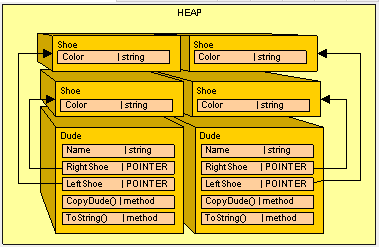在本系列的第一篇文章《C#堆栈对比(Part Two)》中,介绍了值类型和引用类型在参数传递时的不同,本文将讨论如何应用ICloneable接口实现去修复引在堆上的用变量所带来的问题。
本文是系列文章的第三部分。
注:限于本人英文理解能力,以及技术经验,文中如有错误之处,还请各位不吝指出。
C#堆栈对比(Part One)
C#堆栈对比(Part Two)
C#堆栈对比(Part Three)
C#堆栈对比(Part Four)
为了更清楚的表达这个问题,我们来考察一下堆上的值类型与堆上的引用类型。首先,我们来看看值类型。跟随如下的类和结构体,我们有一个包含Name和两个Shoe字段的Dude类。我们有一个CopyDude方法方便我们产生一个新的Dude(花花公子)。
public struct Shoe { public string Color; } public class Dude { public string Name; public Shoe RightShoe; public Shoe LeftShoe; public Dude CopyDude() { Dude newPerson = new Dude(); newPerson.Name = Name; newPerson.LeftShoe = LeftShoe; newPerson.RightShoe = RightShoe; return newPerson; } public override string ToString() { return (Name + " : Dude!, I have a " + RightShoe.Color + " shoe on my right foot, and a " + LeftShoe.Color + " on my left foot."); } }
我们的Dude类是一个引用类型(原本中此处为变量类型,作者已更正)并且Shoe结构体是类的一个成员,他们都在堆上。
注:这里体现了值类型是在栈上还是在堆上,完全取决于其生命时的地点。

当我们运行如下的方法时:
public static void Main() { Class1 pgm = new Class1(); Dude Bill = new Dude(); Bill.Name = "Bill"; Bill.LeftShoe = new Shoe(); Bill.RightShoe = new Shoe(); Bill.LeftShoe.Color = Bill.RightShoe.Color = "Blue"; Dude Ted = Bill.CopyDude(); Ted.Name = "Ted"; Ted.LeftShoe.Color = Ted.RightShoe.Color = "Red"; Console.WriteLine(Bill.ToString()); Console.WriteLine(Ted.ToString()); }
我们得到的结果如下:
Bill : Dude!, I have a Blue shoe on my right foot, and a Blue on my left foot.
Ted : Dude!, I have a Red shoe on my right foot,
and a Red on my left foot.
如果我们将Shoe改为引用类型呢?那将就是个问题,更改如下:
public class Shoe { public string Color; }
更改之后再次运行代码,得到的结果如下:
Bill : Dude!, I have a Red shoe on my right foot, and a Red on my left foot
Ted : Dude!, I have a Red shoe on my right foot, and a Red on my left foot
红色的鞋子在另一个人身上,这明显是错的,你能看出这是怎么发生的吗?下图就是内存引用示例:

因为现在我们用Shoe的引用类型代替值类型,并且拷贝引用类型内容时仅仅是拷贝了指针(不是指针真正指向的对象),我们必须做一些额外工作使我们的引用类型的Shoe更符合值类型的行为。
注:上面这个例子中当Shoe为值类型时,已经伴随Dude的构造方法生成了一个完全独立的结构体Shoe对象,所以Bill为蓝色的鞋,Ted为红色的鞋;当Shoe为引用类型时,Shoe仅仅初始化了一次,所以Ted在使用Shoe时,其实更改的还是唯一初始化一次时的Shoe的内容,所以导致了最后大家都为红鞋。下文会应用深拷贝解决引用类型复制指针的问题。
幸运的是,我们有一个ICloneable接口来帮我们解决问题。这个接口是一个基本的契约,所有Dudes遵守这个契约并且规定如何按顺序的复制避免Shoe Sharing问题。我们所有将被复制的类应该使用ICloneable接口,包括Shoe类。
ICloneable包括一个方法:Clone()
下面我们将实现这个接口: public class Shoe : ICloneable { public string Color; #region ICloneable Members public object Clone() { Shoe newShoe = new Shoe(); newShoe.Color = Color.Clone() as string; return newShoe; } #endregion }
在Clone内部,我们仅仅是New了一个新的Shoe对象,复制所有引用类型并且拷贝值类型,然后返回一个新对象。你可能注意到了String类已经实现了ICloneable接口,所以我们能调用Color.Clone方法。因为Clone返回一个对象的引用,我们必须在设置Shoe的颜色之前将类型显示转换成Shoe类型。
注:String类型是一种特殊的引用类型,其表现形式类似于值类型,因为字符串不可改变,如果改变则产生一个新对象,请参考这里。
下一步,在我们的CopyDude方法中我们需要克隆Shoes代替拷贝。
public Dude CopyDude() { Dude newPerson = new Dude(); newPerson.Name = Name; newPerson.LeftShoe = LeftShoe.Clone() as Shoe; newPerson.RightShoe = RightShoe.Clone() as Shoe; return newPerson; }
现在我们运行主方法:
public static void Main() { Class1 pgm = new Class1(); Dude Bill = new Dude(); Bill.Name = "Bill"; Bill.LeftShoe = new Shoe(); Bill.RightShoe = new Shoe(); Bill.LeftShoe.Color = Bill.RightShoe.Color = "Blue"; Dude Ted = Bill.CopyDude(); Ted.Name = "Ted"; Ted.LeftShoe.Color = Ted.RightShoe.Color = "Red"; Console.WriteLine(Bill.ToString()); Console.WriteLine(Ted.ToString()); }
我们得到如下结果:
Bill : Dude!, I have a Blue shoe on my right foot, and a Blue on my left foot
Ted : Dude!, I have a Red shoe on my right foot, and a Red on my left foot
这就是我们想要的。

作为一个练习,我们希望总是克隆引用类型和复制值类型。(这将降低当你调试程序错误时所购买治疗头疼的阿司匹林的数量)
所以,在头疼降低的情况下,让我们走的更远一些并且让我们整理下Dude类实现ICloneable接口方法代替CopyDude方法。
public class Dude: ICloneable { public string Name; public Shoe RightShoe; public Shoe LeftShoe; public override string ToString() { return (Name + " : Dude!, I have a " + RightShoe.Color + " shoe on my right foot, and a " + LeftShoe.Color + " on my left foot."); } #region ICloneable Members public object Clone() { Dude newPerson = new Dude(); newPerson.Name = Name.Clone() as string; newPerson.LeftShoe = LeftShoe.Clone() as Shoe; newPerson.RightShoe = RightShoe.Clone() as Shoe; return newPerson; } #endregion }
我们所要做的仅仅是通过使用Dude.Clone改变Main方法中的内容。
public static void Main() { Class1 pgm = new Class1(); Dude Bill = new Dude(); Bill.Name = "Bill"; Bill.LeftShoe = new Shoe(); Bill.RightShoe = new Shoe(); Bill.LeftShoe.Color = Bill.RightShoe.Color = "Blue"; Dude Ted = Bill.Clone() as Dude; Ted.Name = "Ted"; Ted.LeftShoe.Color = Ted.RightShoe.Color = "Red"; Console.WriteLine(Bill.ToString()); Console.WriteLine(Ted.ToString()); }
最终的结果是:
Bill : Dude!, I have a Blue shoe on my right foot, and a Blue on my left foot.
Ted : Dude!, I have a Red shoe on my right foot, and a Red on my left foot.
所以一切都很正常。
有一个很有意思的地方需要注意,System.String的caozuofu.html" target="_blank">操作符“=”真是的克隆了字符串,所以你不必担心重复的引用。然而你必须注意内存膨胀。如果你回头看看图示,字符串是引用类型,它真的本应该是一个指向堆的指针,但是简单起见,它的作用类似于值类型。
作为一个练习,如果我们打算每次都拷贝对象,我们应该实现ICloneable接口。这将确保我们的引用类型有点像模仿值类型的行为。正如你所见到的那样,记录我们正在处理的变量是重要的,因为引用类型和值类型在创建内存上的区别。
在这下一篇文章中,我们将审视一种降低内存印记的方式。
1. 引用类型的拷贝一定要注意是深拷贝,还是简单的指针复制的浅拷贝。
2. System.String类型是特殊的引用类型,实际作用效果类似于值类型。
3. 引用类型应该实现ICloneable接口,实现深拷贝,即对象拷贝而非指针拷贝。